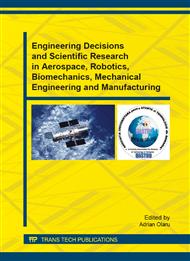p.194
p.205
p.213
p.219
p.225
p.233
p.238
p.247
p.255
Evaluation and Improvement of the Spindle Thermal Transfer
Abstract:
The main source of heat generation in a spindle is the friction torque in the ball bearing angular contact. The thermal and structural behavior of both spindle shaft/housing and bearings is characterized by the thermal expansion and the rate of heat generation depending on the operating speed. To evaluate the temperature distribution and its effects on the axial and radial deformations a simulation procedure is required. This paper is a presentation of the numerical models performed using the (ANSYS) commercial finite element software in order to assess the thermal behavior effect on the spindle nose axial deformation. Two numerical models were designed and simulated; the first model is a classic spindle in which heat dissipation of the bearings is removed by conduction and convection with the environment and with the second model, the generated heat is removed by water cooling circuits to improve the temperature distribution and axial deformation in the housing and spindle shaft.
Info:
Periodical:
Pages:
225-232
Citation:
Online since:
October 2013
Authors:
Keywords:
Price:
Сopyright:
© 2013 Trans Tech Publications Ltd. All Rights Reserved
Share:
Citation:


